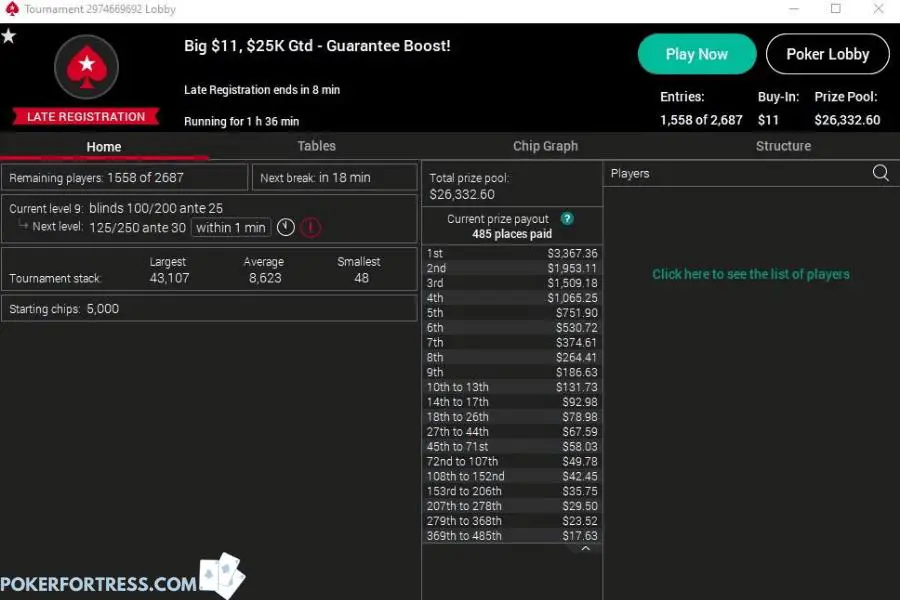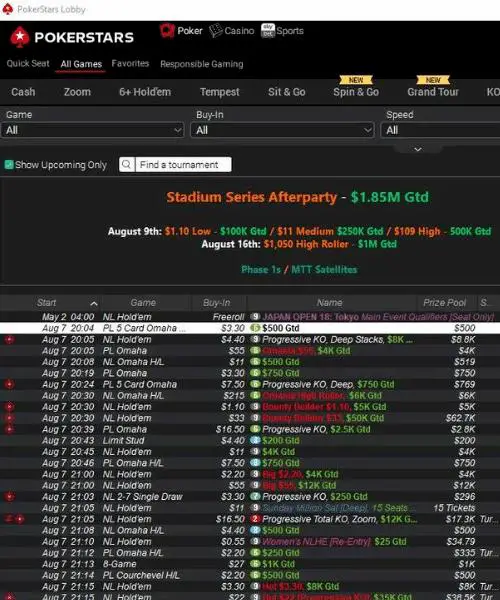Here’s the Typical Payout Structure for a Poker Tournament – Poker Fortress
Have you ever wondered why payouts are different from the advertised tournament prizes? Unless there are only 2 to 4 entries, tournaments can’t be winner-takes-all games. Each cardroom has its payout structure when distributing their prizes, and it determines how much a player takes home from his participation.
The typical payout structure for a poker tournament depends on the number of entries. If it only has 28 participants, the winner takes home 33% of the pool. However, this percentage goes down as more players participate. In events with 350 to 500 entries, the winner gets 22.5% to 25.5% of the pool.
The tournament winner takes the most significant cut in the prize pool, but it’s not as simple as what many people think. We’ll talk about the tournament payout structure in great detail to help you understand how professionals make money in MTT.
 Tournament payout structures are always top-heavy. Min cash is usually around double the buy-in, but the winner gets 25% or even 35% of the whole prize pool.
Tournament payout structures are always top-heavy. Min cash is usually around double the buy-in, but the winner gets 25% or even 35% of the whole prize pool.
Want to start crushing the tournaments? Here is a list of 3 great tournament poker books to become a crusher. Book 1 will teach you a solid fundamental tournament strategy so you don’t make any big mistakes. Book 2 shows you how to crush the final table and book 3 goes through 50 hands in detail when you are deep in tournaments:
ImageTitlePricePrimeBuyTopWinning Poker Tournaments One Hand at a Time Volume IPrimeEligibleCheck on AmazonWinning Poker Tournaments One Hand at a Time Volume IIPrimeEligibleCheck on AmazonWinning Poker Tournaments One Hand at a Time Volume III (Volume 3)PrimeEligibleCheck on Amazon
Prices and images pulled from the Amazon Product Advertising API on:
If on the other hand you already know how to play tournaments and want to make it to the high stakes then it will make sense to get in-depth advice from someone who has already won several WSOP bracelets. With over $23,000,000 in the tournament winnings, he is the right man to teach the advanced expert strategies (warning: this poker tournament course is not for beginners, but for those interested to beat high roller games).
Tournaments and Cash Games Comparison
Tournaments and cash games are very different when it comes to the money that a player makes. When you’re participating in a cash game, you join by using your bankroll. Any amount that you win goes directly to you as your actual money.
If you enter a game with a $500 buy-in, you spend $500. The casino takes out a percentage for each pot, and whatever amount you receive after that goes straight to your pocket. So, if you were able to accumulate $2,000 worth of chips, you’re betting $2,000 of your actual money. Your goal in playing cash games is to win as many games in the shortest time possible.
In a tournament, every player joins by paying the entry fee and rake. The rake is usually 10% of the entry fee, but it can go as high as 30% in smaller tournaments.
So if you participate in an event with an entry fee of $100 and a 10% rake, you’ll only lose $110, even if you’re the first player that gets eliminated. However, the prize that you’ll receive for your participation depends on how high your rank will be after the tournament.
Common Tournament Formats
Similar to cash games, tournaments have different formats that can affect the amount that the winner receives. 100% of the entry fee collected from all the entries go directly to the prize pool. The more entries there are in a tournament, the more money there is for the top players to split. To make it easier for you to understand a typical payout structure, let’s go through the different formats that tournaments take.
Freezeout
Freezeout tournaments are the most common format that you’ll find because it’s the simplest to manage. It’s also the easiest to set up because the cardroom only needs to have enough participants. When you participate in freezeouts, you only have to pay the entry fee and rake, and then you’ll receive the chips that you’ll use throughout the tournament.
Players can only join once, and when they run out of chips, they’re out of the game. These chips don’t have any monetary value, and the winner of the tournament will be the player who beats the other players and collects all the chips.
It is also very easy for a casino to calculate how many poker chips are needed for the tournament, as it knows exactly how many people are participating and each of them gets the same amount of chips.
 Example of a payout structure on PokerStars for $11, $25k Guaranteed Tournament. 9th place gets only 18x the buy-in, while the winner takes home more than 300x the buyin.
Example of a payout structure on PokerStars for $11, $25k Guaranteed Tournament. 9th place gets only 18x the buy-in, while the winner takes home more than 300x the buyin.
Rebuy
Rebuy tournament is the most complicated of the three because participants have the chance to replenish their chips before a rebuy period ends. In all cases the rebuy period ends before the players are in the money and often an add-on is often possible during the last break, after which rebuys aren’t possible anymore.
In the past, rebuy tournaments are the favorite of many deep-pocketed players because they can join the game with so much advantage.
Nowadays, cardrooms enforce different policies to keep parity and prevent deep-pocketed players from dominating their table.
The most common rule for rebuy tournaments is that players can only rebuy at the start of the game and only when their chips fall below the threshold.
For example, if the rebuy threshold is 20% of starting chips, a player can’t rebuy unless they reach it, or get eliminated from the game. Even if they reach it, they still can’t rebuy in the middle of the game, they need to wait until the current hand is over. Most organizers also prohibit players from rebuying more than the entry amount.
Reentry
Reentry is similar to rebuy, but it’s more straightforward and easier to understand. Players can buy back into the tournament only if they get eliminated. However, instead of allowing the player to continue his game, the organizers will treat it as a new entry, and they will assign the player to a different table (not always the case).
You can buy back into the tournament as many times as you want (but sometimes it is limited to only 1 re-entry), but as it progresses, it’ll be less appealing for anyone to want to re-enter. That’s because players can only buy the same number of chips that they had when they started, while the other players accumulate chips and the blinds increase.
It gets harder for reentries to make a difference in the tournament, especially when the chips that players get is only enough to cover the blinds.
Calculating the Prize Pool for Tournaments
We had to go through the different tournament formats because they directly correlate with the prize pool. Remember, the more entries a tournament gets, the higher the prize will be, and the more money there’ll be for the top players to split.
Each format has its pros and cons, so to help you gain a better understanding of the tournament payout structure, let’s discuss how these formats affect the money that the winners receive.
Pros and Cons of Freezeout Tournament Prize Pool
Since players can’t re-enter the tournament, you can calculate the prize pool as soon as it starts. There will be no changes with the structure, and you already know how much you’ll receive as the winner. When you participate in a freezeout tournament, the organizers will often announce the payout structure at the beginning of the game.
Unfortunately, the prize pool will remain the same throughout the tournament. Although cardrooms will adjust the payout structure depending on the number of participants, a low prize pool will remain the same if they don’t get enough traction at the start. A $100 tournament will only have a $5,000 pool if it only gets 50 participants.
Low prize pools often discourage players from participating, so some cardrooms have a guaranteed prize as a way to entice players to join.
It means that if the number of participants doesn’t reach their target number, the cardroom will cover the difference and still distribute prizes according to the guaranteed amount.
 Just like in live games, online also, the majority of tournaments have a guaranteed prize pools.
Just like in live games, online also, the majority of tournaments have a guaranteed prize pools.
Pros and Cons of Rebuy and Reentry Tournament Prize Pool
If you’re going to participate in a rebuy or reentry tournament, the prize pool will always be higher than the number of initial entries. When organizers use these tournament formats, many players will buy back into the game for another chance to be part of the prize pool.
Since 100% of the entry fee goes straight to the prize pool and players will buy back into the game more than once, the top players will receive more. Despite the complexities that rebuy and reentry tournaments have, cardrooms still use this tournament format to encourage more players to join their event.
Unfortunately, since rebuys and reentries happen in the middle of tournament games, no one can know how much the winner will actually receive. Even if the organizers limit the number of times each player can buy back, it’ll still be impossible to determine how many players will spend more to get back into the game.
Tournament Payout Structure
Now that you’re aware of the factors that can affect the prize pool, let’s talk about its payout structure. Tournaments rarely use the “winner-takes-all” approach when organizing, and they’ll always split it to favor the top players. In fact, a typical tournament will award 60% to 70% of the pool to the top 5%, while the remaining 30% to 60% goes to the top 10% to 20%.
Top-heavy payout structure and many participants mean it might take a while before you realize how good you are at tournaments. And furthermore, you need to be okay with certain things in order to be a professional tournament poker player.
We understand that it can be difficult to visualize the payout structure, so here’s a table to help you figure out how much the top players will get from participating in STT and MTT:
Typical STT Payout Structure
Entries / Position2 to 4 Entries5 to 7 Entries7 to 10 Entries1st100%65%50%2nd—35%30%3rd——20%4th———Payout structures of STT (Sit & Go’s).
Typical MTT Payout Structure
Entries / Position8 to 12 Entries13 to 18 Entries19 to 27 Entries28 to 36 Entries37 to 50 Entries51 to 60 Entries1st50%40%40%33%29%27%2nd30%30%23%20%18%15%3rd20%20%16%15%13%13%4th—10%12%11%10%10%5th——9%8%8%9%6th———7%7%7%7th———6%6%7%8th————5%5%9th————4%4%10th—————3%Payout structures of small field tournaments.
Of course, these tables don’t represent the structure that different cardrooms use when splitting the prize pool. These will only provide you with an idea of how cardrooms split the prize. However, if there’s one thing that will always remain, it’s that these structures will favor the top-ranking players.
As you can see, most of the participants won’t receive anything, but the prize consolidates as the rankings move toward the top. In single table tournaments, only a third of all the participants will receive their cut in the pool, while in MTTs, it can go anywhere from 10% to 30% of the participants.
The winners’ prize comes from the entry fees of the remaining 67% to 90% of the players. When you’re playing cash games, the money goes straight to your account, and you can take down as many players as you want. Winning the tournament is the same, but you’re managing the risks because you can never lose more than the amount you spent to join.
The prize for winning MTT may seem very small compared to the money that you can make from cash games. In a $100 tournament with 50 participants, the winner only takes home $1,450. In cash games, you can get the same amount for winning one pot. However, comparing the two in terms of the money that you can make is wrong.
One reason is that in cash games, you’re using your actual bankroll to fund your bets. To make $1,450 in a one on one game, you’ll have to risk $1,450 of your money. Even in 9-max games, you still need to risk more to build a $1,450 pot.
In tournaments, the entry fee is the only money that you risk. If you get eliminated, you only lost $100, but you stand a chance to win the same amount.
MTT isn’t for everyone because it’s about managing the risks while maximizing your chances of winning a large pot. It also takes a lot of skills to succeed in tournaments, and you need to protect your stacks to avoid getting eliminated until the money round starts.
If winning $1,450 for an entry fee of $100 isn’t that appealing, you may want to consider a much bigger tournament. The calculation that we provided is only for the typical cardrooms, which only gets a handful of players. However, with the popularity of poker, it’s not that hard to find tournaments with over 500 entries! There are even some events that get thousands of participants.
The payout structure will, almost, always depend on the number of entries. The more participants a tournament gets, the more complicated the payout structure becomes. That’s why most cardrooms only use the freezeout format to limit the number of entries that they get. This format also makes it easier to calculate the amount that each player receives.
The table below will demonstrate how organizers distribute the prizes when there are 500 to 2000 participants. To make it easier for you to visualize the payout structure for large tournaments, we’re only going to look at a structure that pays the top 10% of the players.
MTT Payout Structure to Compensate the Top 10%
Entries / Position501 to 700701 to 800801 to 10001001 to 12501251 to 15001501 to 17501751 to 20001st24%23.5%23%22.5%22%21.75%21.5%2nd14%13.75%13.5%13.25%13%12.75%12.5%3rd8.8%8.8%8.5%8.5%8.3%8.3%8.1%4th6.8%6.8%6.5%6.5%6.3%6.3%6.1%5th5.8%5.8%5.5%5.5%5.3%5.3%5.1%6th4.1%4.1%3.9%3.9%3.8%3.8%3.7%7th3.1%3.1%2.9%2.9%2.8%2.8%2.7%8th2.1%2.1%1.9%1.9%1.8%1.8%1.7%9th1.5%1.5%1.3%1.3%1.25%1.25%1.15%10th1.1%1.1%1%1%0.95%0.95%0.85%11-151.1%1.1%1%1%0.95%0.95%0.85%16-200.85%0.75%0.7%0.7%0.65%0.55%0.55%21-250.75%0.65%0.6%0.6%0.55%0.45%0.45%26-300.65%0.55%0.5%0.5%0.45%0.4%0.4%31-350.55%0.5%0.45%0.45%0.4%0.35%0.35%36-400.5%0.45%0.4%0.4%0.35%0.3%0.3%41-500.37%0.3%0.28%0.24%0.24%0.24%0.2%51-600.3%0.27%0.24%0.2%0.2%0.2%0.19%61-75 0.25%0.22%0.19%0.19%0.19%0.18%76-100 0.21%0.15%0.15%0.15%0.15%101-125 0.14%0.14%0.13%0.13%126-150 0.13%0.12%0.12%151-175 0.11%0.11%176-200 0.11%Example of payout structures from 500 to 2000 participants.
If you’re participating in a $1,000 tournament with a 10% rake, you only need to pay $1,100 to join. If you are in the top 10%, you start playing for money. 0.11% of the prize pool may not seem much, but it’s equivalent to $2,200, which doubles the amount you spent to join the tournament.
The payout structure for tournaments varies, depending on the number of players that they’re getting. But the initial goal for anyone is to stay in the game until 90% of the players get bust.
When a tournament has the same structure and gets 2000 participants, your first goal should be to reach the top 200 players—that’s where the money round starts. It guarantees twice the amount you spent, and from there, the cash prizes that you get will increase as more players get eliminated.
That’s the reason why MTT players have a different approach when playing poker. If you’re playing cash games, your goal is to win as much as possible in the shortest time. With that approach, players tend to be more aggressive than if they’re in a tournament.
In tournaments, your skills in playing your hand will determine whether you win the biggest prize. It is a good strategy to take the advantage of your skill early in the tournament when there are still many weak players and you are playing deep. The deeper you are, the bigger your advantage is. Just keep in mind that a mistake can easily cost you, and the next moment you can be out of the tournament.
Conclusion
Tournaments have different formats that can affect the prize pool and ultimately affect the payout structure. That’s why it would be best to understand these formats to help you find a tournament with better compensation.
Regardless of the format that you participate in, the goal when playing MTT is to manage your stack and make sure that it lasts longer than most players. You also need to consider the value that you’re getting from your hands because if you play too tight in the early stages of a tournament, it’ll be tough for you to keep up on the next round.
Free trial



